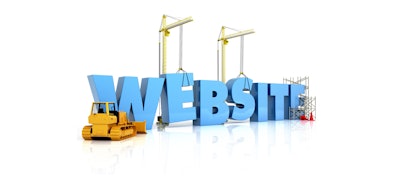
Really, I’ve learned hundreds of lessons just from my first B2B website build, but that doesn’t help with a catchy headline. It would also be a MUCH longer article and nobody got time for that. Let’s start with the fact that having a website is crucial. I don’t know about you, but if I Google a company and I can’t find them online, my first thought is, “It doesn’t exist” or “They’re sketchy,” and my last thought is usually, “Oh maybe I misspelled it.” Regardless, it’s 2016, if dogs can have an Instagram, your business should have a website.
Now that we’re all on the same page, let’s talk about the website build. In my humble opinion, these lessons are just as important to the party building the website (e.g an agency) as they are to the party who wants a website built (e.g a client).
1. A website is a tool - treat it like one
I like a “pretty” website as much as the next person, but if I end up on a website and my only thought is, “ooh shiny,” there is a bigger problem. I’m going to be honest, if a website has the right structure, it might not need a redesign. There are plenty of other ways a B2B website can become a lucrative tool, worth an investment. A B2B website should be able to do the following:
- Educate me on the business
- Earn my trust (as in, convince me that this business is the thought leader)
- Allow me to do all the necessary research before any transactions
- Offer information throughout my journey as a buyer
- “Capture” my information, so you can continue to “nurture” me
Now, all of this can be accomplished as long as you keep reading to at least point #2...
2. The groundwork is the most important part
During a website build there is crucial moment that determines how the next 3-6 months will play out. The crucial moment is the very, very beginning. Shocker, I know. But I can’t stress this enough. Everyone gets so excited about the design and the development that sometimes we rush through the timeline, the sitemap, the wireframes and the conversion path mapping. I get it, I really do, but if these four steps aren’t given the attention they deserve, two things will happen:
1) The website probably won’t launch on time — if it does it’s because there will be a lot of late nights, a few bicker matches and a lot of unnecessary passive aggressiveness.
2) It won’t be the tool we all know it could and should be.
So let’s get into what these things are and why these things are important.
The timeline: A timeline determines all deadlines and tries to ensure that the build doesn’t take 18 months when it should be 5 months. As a project manager, I’m a little biased about the importance of this step, but a lot of anger and disappointment can be avoided if everyone has the appropriate expectations. Expectations that are based on the timeline. In the timeline it should be clear when everything starts, when things are due from the agency and from the client and there should ALWAYS be buffer room. Let’s face it, nothing goes as planned. Everyone can have the best intentions but not everything can be accounted for - so I vote that we all pad the timeline. You know when you go to a restaurant and you hear it’s a 45 minute wait and you go, “Ugh,” but then it’s actually 20 minutes (!!) isn’t that a great feeling? Well imagine the reverse. Ya, that’s where the anger and disappointment roll in.
The sitemap: OH MY GOD THIS IS SO IMPORTANT. This is the what’s going to live on the website. This is the infrastructure. This is when a decision is made about what should live on the website and where. But it’s usually just a sheet of paper. It looks like an outline. It’s not very exciting. I cannot tell you how many times this has been ignored by both the agency and the client. But here’s the problem, you’re in design phase 2, or, even worse, development and you go, “Where should this very vital piece of information live?” And then you have to Frankenstein the website. It’s just so upsetting. End of rant.
The wireframe and the conversion path mapping: I’m going to combine these two because they are related. These things are the blueprint, it’s what makes the website a tool. It’s the brains behind the design. Please take the time to think through this, review it and provide revisions because this is the website, this is the house. The design is just the wallpaper, the paint, the curtains. I’m going to circle back to lesson No. 1 here. A website is a tool — treat it like one.
The next two points are shorter, I promise.
3. There should be buy-in from everybody
You’ve spent all of this time on the groundwork and you have a great infrastructure and you’ve built a beautiful website, only to have some guy not like something that is actually pretty vital to it being a useful tool. The team gets it, the client gets it but the sales guy doesn’t get it, or the guy in the Boston office doesn’t get it, or the CEO doesn’t get it...you get the point. Collect everyone who will be approving the website, using the website, making the website and get them all on the same page. A difficult challenge I admit, but I believe in you.
4. It doesn’t need to be perfect, because guess what? A website isn’t static
This last thing is hard for me to say, because I always strive for perfection, but when the website launches it doesn’t need to be perfect. Do not confuse this with not having an infrastructure. The things I mentioned in lesson No. 2 should be as polished as possible, and in fact when building the infrastructure, growth and change should be considered. What doesn’t need to be absolutely perfect is the copy, a few pages can be missing (you can always add some), the design, the fancy functionality. It should be added, those are all important things to have, but getting your website live, so you can use it as a lucrative tool is more important. A website is living and breathing. It should NOT be static. It should not be treated as a project that is ignored until it needs to be “spruced” or “redone” again. No, it should be worked on constantly. And there is so much you can do with a website. If you don’t believe me, just Google “inbound marketing.”
 Masha Popelyukhina, Project Manager at Gorilla 76
Masha Popelyukhina, Project Manager at Gorilla 76Masha Popelyukhina is a project manager at Gorilla 76. She is the liaison between the account coordinators and the other team members at Gorilla 76. She keeps things organized and makes sure nothing slips through the cracks. When she’s not crossing things off the to-do list, she’s probably curled up with an Agatha Christie book (read: watching Netflix), at a music festival, painting, or brewing homemade ciders and sodas. Masha is a graduate of Washington University in St. Louis.






















